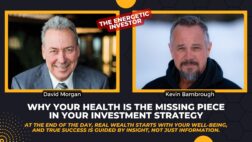Jim Goddard: My guest is David Smith, Senior Analyst for The Morgan Report which you can find online at Silver-Investor.com. Welcome to the show David.
David Smith: Good morning Jim.
Jim: Today, we’re talking about the high risk of mining – which has now become even riskier for both investors and the miners. We just had that tailings pond collapse in central BC recently.
Thankfully, not much heavy metal contamination, as far as we know right now. The water will be safe for humans but the sediment probably will wipe out fish for years and David, we know environmental concerns are always key for people when they have to develop a mine. You say it used to take eight years lead time to start a gold mine. Now it’s 12-20 – that’s, a whole generation.
David: It can be that long Jim in terms of the discovery to actual production process. Certainly 12 to 15 years is probably becoming the norm now. The topic we’re dealing with today I think is an important one. I think it’s underappreciated by people in the gold and silver market, as well as base metals – what we call the mining footprint.
It’s what effect that a mining operation has from exploration through production and then eventually a restoration of the land, going back to where it was beforehand. Mining is already very heavily regulated today compared to what it was 10 or 15 years ago.
It’s going to become even more so, and can a good thing in a way. In terms of making sure that everybody does the very best they can to mitigate risk and to lessen the likelihood of failures like we saw with this tailings pond collapse.
The point is that the risk will never be eliminated altogether but it is going to mean that it will be one more cost factor that pushes up the price of gold and silver going forward, along with the demand pushing that supply, which will lead higher prices too. So I think investors have to factor that in – as an element that has always been there, but now, it’s going to become even more important as we move forward.
Jim: Take a look at the Pascua-Lama mine on the Chilean-Argentinean border. Environmental concerns there have kept that operation from getting underway. They thought it would cost maybe four billion to start this mine. Now they say it be $11 may be $11 billion before they even start producing.
David Smith: It’s pretty amazing that figure. You just wonder how many ounces of gold and silver they have to dig up break even on that. That internal rate of return could be a long time coming back. I think you’re going to see these questions being raised, and they’re legitimate to a certain extent, on any new operation, anywhere on the globe.
As David Morgan has said for many years, everything we use is either grown or mined. So when people look at these things, they have to try to expect some kind of balance – understand that there is a tradeoff. If we’re going to have the modern conveniences we have come to depend upon for a livelihood, and even to stay alive, we will need to keep mining.
We just need to operate as responsibly as possible. Steve Todoruk, on Sprott’s Thoughts, penned an excellent column where he talked about the tradeoff that you and I have been discussing. Like he said, there are new ways that have been developed, such as a dry stacking process for tailings ponds which make it less likely that what we saw here last week in BC and also down in Sonora State in Mexico – where we had a copper concentrate spilled into a river – where these things will be are less likely to happen and when they do, there will be smaller damage into the environment.
Possibly not everyone who is listening to us knows what a tailings pond is. So it might be appropriate to give a quick definition on that Jim.
Jim: Well, go ahead David.
David: A tailings pond is where the residue from production goes – either from the floatation circuit used for gold and silver, or from open pit mining that puts the product in a leach pad to separate out the minerals.
That’s where the residue is pumped into a predesigned pit that has an impermeable layer on the bottom so that it doesn’t leach into the ground. That liquid over time will evaporate, leaving this residue behind. It’s highly treated, making it not nearly as toxic as it was during the processing phase. It still maintains a certain level of toxicity and of course if the tailings dam breaks, either through a lack of maintenance, due to earth shifting or flood, it can create some pretty serious consequences.
Where I’ve been in some of the hilly parts of Central Mexico, where there isn’t much flat space, some of these tailings ponds which over time have solidified and don’t have any liquid residue left at all, because the water is put back into a stream; in some cases it’s as pure or more so than when it was taken out of the ground.
These flat sections are covered with a bit of earth and used as soccer playing fields. So they can actually serve a positive purpose, but with an operational mill, it’s going to be an ongoing concern. You do have continual liquid residue being pumped into the tailings pond. That’s why it’s important to Skeep an eye on things and make sure that there aren’t any leaks or disruptions.
Jim: David, do we have to use tailings ponds? Can’t they recover the slag or whatever is leftover from the process some other way?
David: For the most part, there’s going to be some residue and some of that residue has to do with simply the non-metal items that were in there in the first place. But it’s going to be really difficult to totally eliminate that consideration, but there are other procedures that are currently being used or tested. Certain bacteria will actually consume metals and can make them much less toxic. There is also a process called “dry stacking” which is showing promise.
So I’m thinking a long term view would be to have a situation where let’s say you had a tailings pond which would be filled up at some point and then allowed to coalesce into solid ground. Then you could start a new one so that you wouldn’t have a pond that is maybe 20, 30, or 40 years old, but rather one that could be reconfigured, say every five or ten years- that would certainly mitigate things.
So the mining sector is continually working to improve what they do to make it more cost-efficient, to make it safer. For example, removing much less waste rock where it’s initially being dug blasted, and bringing out a higher grade of ore. So these things continue to take place, but we’re always going to see the occasional spill and disruption, because by definition, we’re all fallible creatures in our pursuits, regardless of what that activity is.
Jim: What is happening with gold right now?
David: Jim, we’re still in a broad trading range. Actually it has become quite narrow, with a downward slope. There are chart patterns such as triangles, which indicate that we’re going to see some kind of a resolution here fairly soon, one way or the other.
Of course our bias is to the upside. We think the likelihood is that we will see higher gold prices in the breakout pattern rather than lower ones, but we don’t know for sure. Each side has their own view as to what that’s going to look like but I think if you and I are having this discussion even a few weeks down the line, we’re going to see a substantial difference in where gold and silver are trading, from where they are today. Our presumption at this point is that that could well be to the upside.
If it is to the downside, then we will have more work to do in base building before we see that upside movement, but we are entering into a seriously strong period for the metals, so that might be the way to bet.
Jim: Of course there’s the assumption that sometime this fall there’s going to be a major correction in the stock market, but the markets haven’t behaved the way we thought they would for the last two years. Can you comment on that?
David: The broad markets are holding up pretty well as late arrivals continue to pump a lot of money into them. So we will see, but again we’re entering into the September- October period, where traditionally you see a significant stock market correction.
We will just have to watch. We all have our views, but until Mr. Market gives us a definitive answer, it’s best to watch and wait. After we’ve established our positions we shouldn’t keep adding just because something might happen, but literally wait for it to happen. Then add more if the action confirms your analysis.
Jim: Is palladium still going to be hot?
David: It looks like it. It has now made 13-year highs. It punched above $900 briefly, so it would not be surprising to see palladium trade in four digits before the end of the year.
Jim: So there is some hope for metals after all and is palladium is the shining boy right now.
David: Yes it’s leading the charge. It’s up something like 25 percent this year – we’ve been pretty fortunate in our analysis to be correct on that, saying that palladium and then platinum would lead the metals higher. So far, so good. We will just watch and see how our big picture premise plays out.
Jim: Is this mostly due to China’s deciding that they’re going to put catalytic converters on more of their cars now?
David: I believe it’s due to a convergence of elements Jim. We’ve got some very strong auto demand around the world. We have new uses being found for platinum and palladium. We have continued supply concerns coming out of South Africa and Russia, and we have rising demand across the board for the PGMs. So, all of these things are pushing the supply-demand matrix into the direction of continued tight supplies, leading inexorably to higher prices over time.
Jim: Thanks a lot for chatting with us David.
David: You bet Jim.
Jim: My guest has been David Smith, Senior Analyst for The Morgan Report which you can find online at Silver-Investor.com. You’re listening to HoweStreet.com Radio. Find us on Twitter, @TalkDigitalNet. Comments about the show can be sent to info@HoweStreet.com. I’m Jim Goddard.
[Comments made on HoweStreet.com Radio are an expression of opinion only and should not be construed in any matter whatsoever as recommendations to buy or sell any financial instrument at any time. Available online at TalkDigitalNetwork.com, HoweStreet.com Radio is a production of Howe Street Media, Incorporated.]
David Morgan is a precious metals aficionado armed with degrees in finance and economics as well as engineering, he created the Silver-Investor.com website and originated The Morgan Report, a monthly that covers economic news, overall financial health of the global economy, currency problems, and the key reasons for investing in precious metals.
As publisher of The Morgan Report, he has appeared on CNBC, Fox Business, and BNN in Canada. He has been interviewed by The Wall Street Journal, Futures Magazine, The Gold Report and numerous other publications. If there is only one thing to teach you about this silver bull market it is this… 90% of the move comes in the last 10% of the time! Where will you be when this happens?
Offer does not apply to Premium Memberships.



